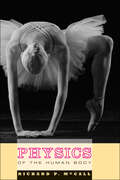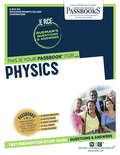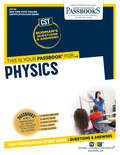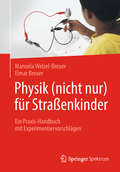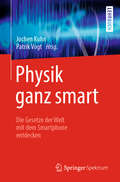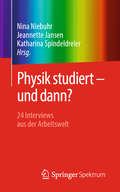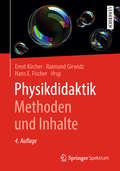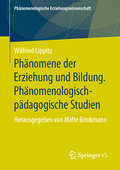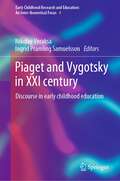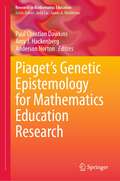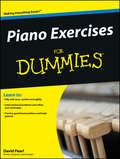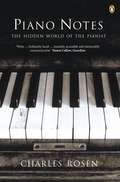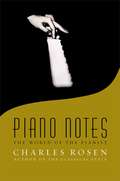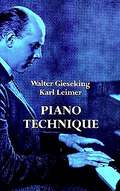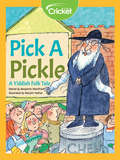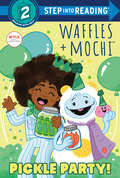- Table View
- List View
Physics for the IB MYP 4 & 5: By Concept (MYP By Concept)
by Paul MorrisThe only series for MYP 4 and 5 developed in cooperation with the International Baccalaureate (IB)Develop your skills to become an inquiring learner; ensure you navigate the MYP framework with confidence using a concept-driven and assessment-focused approach presented in global contexts.- Develop conceptual understanding with key MYP concepts and related concepts at the heart of each chapter.- Learn by asking questions with a statement of inquiry in each chapter. - Prepare for every aspect of assessment using support and tasks designed by experienced educators.- Understand how to extend your learning through research projects and interdisciplinary opportunities.This title is also available in two digital formats via Dynamic Learning. Find out more by clicking on the links at the top of the page.
Physics of the Human Body
by Richard P. McCallRichard P. McCall's fascinating book explains how basic concepts of physics apply to the fundamental activities and responses of the human body, a veritable physics laboratory. Blood pumping through our veins is a vital example of Poiseuille flow; the act of running requires friction to propel the runner forward; and the quality of our eyesight demonstrates how properties of light enable us to correct near- and far-sightedness. Each chapter discusses a fundamental physics concept and relates it to the anatomy and physiology of applicable parts of the body. Topics include motion, fluids and pressure, temperature and heat, speech and hearing, electrical behaviors, optics, biological effects of radiation, and drug concentrations. Clear and compelling, with a limited amount of math, McCall's descriptions allow readers of all levels to appreciate the physics of the human physique. Physics of the Human Body will help curious high school students, undergraduates with medical aspirations, and practicing medical professionals understand more about the underlying physics principles of the human body.
Physics, AP* Edition (3rd Edition)
by James S. WalkerPhysics determines the behavior of everything in the universe--from the particles that make up atoms, to the tissues of the human body, to galaxies and the multitude of stars they contain. Grouped in pairs that share a common physical theme, these images touch on just a few of the many real-world applications of physics discussed in this text. As you study the material in this book, your understanding of physics will deepen. You will begin to make the connection between magnets and MRI, organ pipes and windpipes, lighthouses and magnifying glasses, hurricanes and galaxies. At the same time, your appreciation for the world around you will increase as you come to recognize the fundamental physical principles on which all of our lives are based.
Physics: Passbooks Study Guide (Excelsior/Regents College Examination Series #No. Q-100)
by National Learning CorporationThe Excelsior/Regents College Examinations (E/RCE) offer you an opportunity to obtain recognition for college-level learning and consists of exams designed to demonstrate achievement and mastery of various college-level subjects, such as the Arts and Sciences, Business, Criminal Justice, Education, Health and Nursing. The E/RCE Physics Passbook® prepares you by sharpening knowledge of the skills and concepts necessary to succeed on the upcoming exam and the college courses that follow. It provides a series of informational texts as well as hundreds of questions and answers in the areas that will likely be covered on your upcoming exam.
Physics: Passbooks Study Guide (New York State Teacher Certification Examination Series (NYSTCE) #No. Q-100)
by National Learning CorporationThe New York State Teacher Certification Exams (NYSTCE) are required for all candidates seeking licensure in the State. The NYSTCE series consists of many different tests assessing skills and abilities necessary for teachers. The Passbook® for the Content Specialty Test in Physics provides hundreds of multiple-choice questions in the areas that will likely be covered on your upcoming certification exam, including but not limited to: mechanics and thermodynamics; electricity; sound and light; radioactivity; and other related areas.
Physik (nicht nur) für Straßenkinder
by Manuela Welzel-Breuer Elmar BreuerDas vorliegende Handbuch ist für Menschen geschrieben, die Spaß am Experimentieren haben, andere für physikalische Phänomene begeistern wollen und nach sorgfältig erstellten und erprobten Anleitungen suchen. Die Autoren zeigen anhand eigener Erfahrungen, wie man Physik unter Verwendung einfacher Materialien vermitteln kann – nicht nur Straßenkindern. Sie beschreiben übersichtlich und systematisch Reihen erprobter Experimentiervorschläge aus den Bereichen der Elektrizitätslehre und Optik. Sie nutzen dabei einfach zu beschaffende Materialien und analysieren die Experimente im Hinblick auf Lernmöglichkeiten und Sprachanlässe. Das Buch entstand aus der Bildungsarbeit mit Kindern und Jugendlichen in schwierigen Lebenslagen in Kolumbien und in Deutschland. Es gibt eine Einführung in Ursachen und Randbedingungen des Lebens auf der Straße und liefert Vorschläge methodischer Zugänge und Möglichkeiten, naturwissenschaftliche Bildung beispielsweise für Straßenkinder oder Flüchtlinge zu realisieren. Die Autoren Prof. Dr. Manuela Welzel-Breuer ist Professorin für Physik und ihre Didaktik an der Pädagogischen Hochschule Heidelberg und betreut verschiedene Forschungsprojekte zum Lehren und Lernen von Physik und Naturwissenschaften auf der Grundlage eigener empirischer Lernprozessforschung und Schulpraxis. Dr. Elmar Breuer ist Lehrer für Mathematik, Physik, Informatik und NWT im Gymnasium Englisches Institut Heidelberg. Parallel ist er als Lehrbuchautor aktiv und übernimmt regelmäßig Lehraufträge an der Pädagogischen Hochschule Heidelberg.
Physik ganz smart: Die Gesetze der Welt mit dem Smartphone entdecken
by Jochen Kuhn Patrik VogtIm vorliegenden Buch werden rund 50 physikalische Experimente vorgestellt, in denen Smartphones oder Tablet-Computer zur Messwerterfassung genutzt werden. Die Autoren decken zahlreiche Themenfelder der Physik ab: Kinematik und Dynamik, Hydrostatik und -Dynamik, Mechanische Schwingungen und Wellen, Akustik, Elektrodynamik und Radioaktivität. Leserinnen und Leser untersuchen beispielsweise mit den Beschleunigungssensoren des Smartphones den freien Fall, messen die Flügelschlagfrequenz von Insekten, bestimmen die Klopfspecht-Art mithilfe ihrer Akustik und untersuchen, wie stark unterschiedliche Materialien radioaktive Strahlung abschirmen. Für jedes Experiment wird der theoretische Hintergrund, die Versuchsdurchführung und -Auswertung besprochen. Eine Aufstellung der genutzten Apps, einschließlich Bezugsquellen und Hinweise zu anfallenden Kosten, ist am Ende des Buches aufgelistet.Alle vorgestellten Experimente sind bewusst als Einzelbeiträge verfasst und können somit unabhängig voneinander gelesen und erprobt werden. Dadurch ist man nicht an die vorgegebene Reihenfolge gebunden und kann sich beim Durcharbeiten des Buches allein von den persönlichen Interessen leiten lassen.Das Buch richtet sich an alle Dozierenden des Fachs Physik, Studierende des Lehramts, Referendarinnen und Referendare, ausgebildete Lehrerinnen und Lehrer und hilft bei der Unterrichtsgestaltung, Ideenfindung und letztendlich Einbindung moderner Medien im Physikunterricht.Die HerausgeberProf. Dr. Jochen Kuhn hat 2002 an der Universität Koblenz-Landau promoviert und dort 2009 habilitiert. Er ist seit 2012 Universitätsprofessor an der Technischen Universität Kaiserslautern und Leiter der Arbeitsgruppe „Didaktik der Physik“. Sein Arbeits- und Forschungsschwerpunkt ist das fachbezogene Lehren und Lernen mit digitalen Medien in Schule und Hochschule.Dr. Patrik Vogt hat sich nach einem Lehramtsstudium in Landau und dem Referendariat in Kaiserslautern im Jahr 2010 am Fachbereich „Natur- und Umweltwissenschaften“ der Universität Koblenz-Landau mit einer Arbeit zur Physikdidaktik promoviert. Nach mehreren Stationen als wissenschaftlicher Mitarbeiter und Realschullehrer leitet er seit 2019 den Fachbereich „Medienbildung, Mathematik, Naturwissenschaften“ am Institut für Lehrerfort- und -weiterbildung in Mainz. Seine Arbeitsschwerpunkte bilden die Einsatzmöglichkeiten mobiler Endgeräte im Physikunterricht, speziell als Messinstrument, die Aufgabenkultur sowie die Physik des Alltags.
Physik studiert - und dann?: 24 Interviews aus der Arbeitswelt
by Nina Niebuhr Jeannette Jansen Katharina SpindeldreierDu studierst Physik oder willst Physik studieren? Du findest Physik spannend, kannst dir aber noch nicht so ganz vorstellen, welche Berufswege man damit später einschlagen kann? Dieses Buch gibt dir einen Einblick in die Welt jenseits des Studiums: 24 Physikerinnen und Physiker aus den unterschiedlichsten Berufsrichtungen geben in Interviews einen Einblick in ihr Tätigkeitsfeld und ihren Weg dorthin. Persönliche und berufsorientierte Tipps helfen bei der beruflichen Orientierung.Aus dem Inhalt:Physikerinnen und Physiker im BerufIndustrie – Forschung auf den Markt bringenSoftware – Mit dem Algorithmus zur LösungWissensvermittlung – Physik greifbar machenWissenschaft in Anwendung – Arbeitsweisen übertragenPhysik und Gesellschaft – die Physik bietet noch mehr
Physikdidaktik | Methoden und Inhalte
by Ernst Kircher Raimund Girwidz Hans E. FischerDas vorliegende Buch bietet den Leserinnen und Lesern einen fundierten Überblick über die Methoden der Physikdidaktik und bietet eine Hilfestellung, hochspannende Themen in den Physikunterricht einzubinden. In Einzelbeiträgen diskutieren Autorinnen und Autoren Methoden und Inhalte der Physikdidaktik – angefangen von der qualitativen Forschung in der Fachdidaktik über Aus- und Fortbildungen von Physiklehrerinnen und -lehrern zur Professionskompetenz und Nature of Science. Daran anschließend werden aktuelle und forschungsnahe Themengebiete und ihre mögliche Einbindung in den Unterricht dargestellt: Bio-, Quanten-, Nano- und Elementarteilchenphysik, Astronomie, Chaos, Physik des Klimawandels und die Physik der Gravitationswellen. Das Standardwerk Physikdidaktik wird in der Neuauflage thematisch getrennt angeboten: Grundlagen und Methoden und Inhalte. Beide Bände richten sich an Studierende des Lehramts Physik, angehende Lehrkräfte im Vorbereitungsdienst und Physiklehrerinnen und -lehrer.
Phänomene der Erziehung und Bildung. Phänomenologisch-pädagogische Studien: Herausgegeben von Malte Brinkmann (Phänomenologische Erziehungswissenschaft #7)
by Wilfried LippitzDer Band versammelt historische und systematische Studien von Wilfried Lippitz der letzten Jahre zur Theorie, Geschichte und internationalen Verbreitung der Phänomenologischen Erziehungswissenschaft. Phänomene wie Sozialität, Leiblichkeit, Responsivität und Alterität werden systematisch reflektiert und pädagogische Grundbegriffe wie Lernen und Erziehen, Generation und Kindheit neu gerahmt. Neben historisch-systematischen und bildungsphilosophischen Studien bilden Texte unter der Fragestellung von Identität und Autobiographie das dritte zentrale Thema dieses Bandes. Er bietet einen übersichtlichen Einstieg in historische, internationale und aktuelle Diskurse der phänomenologischen Erziehungswissenschaft sowie in das Denken und Forschen von Wilfried Lippitz.
Piaget and Vygotsky in XXI century: Discourse in early childhood education (Early Childhood Research and Education: An Inter-theoretical Focus #4)
by Ingrid Pramling Samuelsson Nikolay VeraksaThe book provides a comprehensive analyses of Vygotsky’s and Piaget’s theories implementation in modern preschool education. It analyzes the problem of the relationship between the natural and the cultural in the context of Vygotsky and Jean Piaget theories. Their discourses complemented each other: whereas Vygotsky developed his theory in the direction from society (culture) to the individual child, Piaget’s movement was the opposite: from individual child to society. These two approaches confront modern world with the need to analyze the problem of childhood: is childhood a period of cultural exploration or is it a special form of relationship in which both the egocentrism and consciousness of the child, and the egocentrism and consciousness of culture are represented?Readers will gain insight into the methodology that makes possible to unite up-to-date views based on Vygotsky and Piaget theories on child development and education.
Piaget’s Genetic Epistemology for Mathematics Education Research (Research in Mathematics Education)
by Anderson Norton Paul Christian Dawkins Amy J. HackenbergThe book provides an entry point for graduate students and other scholars interested in using the constructs of Piaget’s genetic epistemology in mathematics education research. Constructs comprising genetic epistemology form the basis for some of the most well-developed theoretical frameworks available for characterizing learning, particularly in mathematics. The depth and complexity of Piaget’s work can make it challenging to find adequate entry points for learners, not least because it requires a reorientation regarding the nature of mathematical knowledge itself. This volume gathers leading scholars to help address that challenge. The main section of the book presents key Piagetian constructs for mathematics education research such as schemes and operations, figurative and operative thought, images and meanings, and decentering. The chapters that discuss these constructs include examples from research and address how these constructs can be used in research. There are two chapters on various types of reflective abstraction, because this construct is Piaget’s primary tool for characterizing the advancement of knowledge. The later sections of the book contain commentaries reflecting on the contributions of the body of theory developed in the first section. They connect genetic epistemology to current research domains such as equity and the latest in educational psychology. Finally, the book closes with short chapters portraying how scholars are using these tools in specific arenas of mathematics education research, including in special education, early childhood education, and statistics education.
Piano Exercises For Dummies
by David PearlThe ideal hands-on reference for piano students who want to strengthen their skills and refine their technique--and the perfect companion and next step to the bestselling Piano For Dummies.Note: CD-ROM/DVD and other supplementary materials are not included as part of eBook file.
Piano Exercises For Dummies
by David PearlPractice, practice, practice to play like Chopin or the Piano Man The piano will help you add a touch of fun to your life, impress your friends at parties, and even reduce stress. It even makes you better at math (really!). Piano Exercises For Dummies is at your service as you learn to make those 88 black and white keys sing. You’ll get a quick overview of the basics before diving into practice routines and sample songs that you can use to improve your skill, whatever your level. This book gives you online access to audio files of the exercises along with digital access to the sheet music shared in the book. Learn from an experienced pianist, composer, and arranger, and start making beautiful music, the Dummies way! Refresh your knowledge of the piano basics so you’re poised and prepared to play the right way Play enjoyable practice exercises and songs designed to teach specific skills and techniques in all genres Go online to access all the audio files, anytime, anywhere Bring a little more joy into your life by stepping up your piano know-how Piano Exercises For Dummies is for new and experienced pianists alike, and useful for improving your skill in any musical style.
Piano Music for Little Fingers: Book 2 (Dover Classical Piano Music For Beginners)
by Ann Patrick GreenThe third volume in this series for pianists ages 4 to 9, this book contains more songs in the already familiar key of G. New topics include the key of F and extended hand positions with six-note melodies, plus the IV chord in all keys, dotted rhythms, dynamics, staccato and legato touches, and two-note and longer phrases. Heartwarming Family Circus cartoons appear throughout the book."Of all the piano instruction books and courses out there, yours is the best by far, because it combines theory, fun, a wonderful variety of songs, and of course, the 5-point learning plan. Thank you for providing such a fantastic piano course for children!" -- Beverly Short, Santa Monica, California"You've really found a wonderful way of making music fun for children with your songs. The songs are infused with spirit, so it makes learning truly enjoyable for students." -- Monica Le, Fullerton, California"I love these books because they work! I have been using them for many years with children 4 years old and up. The big notes make note learning easy and the directions for teachers are clear and methodical. My students and their parents are excited as they graduate from one level to the next. These books truly teach little fingers to play! Thank you, Ann Patrick Green!" -- Carol Orozco, Fullerton, California"I use Ann Patrick Green's books with every student. The larger note size, the use of solfege note reading, the inclusion of theory and the way each book is organized makes teaching and learning easy and fun." -- Lisa Smith, piano teacher
Piano Music for Little Fingers: Book 2 (Dover Classical Piano Music For Beginners)
by Ann Patrick GreenThe third volume in this series for pianists ages 4 to 9, this book contains more songs in the already familiar key of G. New topics include the key of F and extended hand positions with six-note melodies, plus the IV chord in all keys, dotted rhythms, dynamics, staccato and legato touches, and two-note and longer phrases. Heartwarming Family Circus cartoons appear throughout the book."Of all the piano instruction books and courses out there, yours is the best by far, because it combines theory, fun, a wonderful variety of songs, and of course, the 5-point learning plan. Thank you for providing such a fantastic piano course for children!" — Beverly Short, Santa Monica, California"You’ve really found a wonderful way of making music fun for children with your songs. The songs are infused with spirit, so it makes learning truly enjoyable for students." — Monica Le, Fullerton, California"I love these books because they work! I have been using them for many years with children 4 years old and up. The big notes make note learning easy and the directions for teachers are clear and methodical. My students and their parents are excited as they graduate from one level to the next. These books truly teach little fingers to play! Thank you, Ann Patrick Green!" — Carol Orozco, Fullerton, California"I use Ann Patrick Green's books with every student. The larger note size, the use of solfege note reading, the inclusion of theory and the way each book is organized makes teaching and learning easy and fun." — Lisa Smith, piano teacher
Piano Music for Little Fingers: Primer (Dover Classical Piano Music For Beginners)
by Ann Patrick GreenThis is the introductory volume of a three-book set designed to guide young pianists from the most basic techniques and theory to a mastery of the easy classics. The Primer consists of ten lessons, each of which may be divided into smaller or larger segments as needed. Geared toward students ages 4 to 9, this refreshing series features classic Family Circus cartoons."Of all the piano instruction books and courses out there, yours is the best by far, because it combines theory, fun, a wonderful variety of songs, and of course, the 5-point learning plan. Thank you for providing such a fantastic piano course for children!" -- Beverly Short, Santa Monica, California"You've really found a wonderful way of making music fun for children with your songs. The songs are infused with spirit, so it makes learning truly enjoyable for students." -- Monica Le, Fullerton, California"I love these books because they work! I have been using them for many years with children 4 years old and up. The big notes make note learning easy and the directions for teachers are clear and methodical. My students and their parents are excited as they graduate from one level to the next. These books truly teach little fingers to play! Thank you, Ann Patrick Green!" -- Carol Orozco, Fullerton, California"I use Ann Patrick Green's books with every student. The larger note size, the use of solfege note reading, the inclusion of theory and the way each book is organized makes teaching and learning easy and fun." -- Lisa Smith, piano teacher
Piano Notes: The Hidden World of the Pianist
by Charles RosenIn this eloquent, intimate exploration of the delights and demands of the piano, world-renowned concert pianist and music writer Charles Rosen draws on a lifetime's wisdom to consider every aspect of the instrument: from what makes a beautiful sound to suffering from stage fright, from the physical challenges of playing to tales of great musicians, including Vladimir Horowitz's recording tricks, Rachmaninov's hands and why Artur Rubenstein applied hairspray to the keys. Gracefully blending anecdote, history, expertise and memoir, Piano Notes will enchant anyone with a passion for music.
Piano Notes: The World of the Pianist
by Charles RosenCharles Rosen is one of the world's most talented pianists -- and one of music's most astute commentators. Known as a performer of Bach, Beethoven, Stravinsky, and Elliott Carter, he has also written highly acclaimed criticism for sophisticated students and professionals. In Piano Notes, he writes for a broader audience about an old friend -- the piano itself. Drawing upon a lifetime of wisdom and the accumulated lore of many great performers of the past, Rosen shows why the instrument demands such a stark combination of mental and physical prowess. Readers will gather many little-known insights -- from how pianists vary their posture, to how splicings and microphone placements can ruin recordings, to how the history of composition was dominated by the piano for two centuries. Stories of many great musicians abound. Rosen reveals Nadia Boulanger's favorite way to avoid commenting on the performances of her friends ("You know what I think," spoken with utmost earnestness), why Glenn Gould's recordings suffer from "double-strike" touches, and how even Vladimir Horowitz became enamored of splicing multiple performances into a single recording. Rosen's explanation of the piano's physical pleasures, demands, and discontents will delight and instruct anyone who has ever sat at a keyboard, as well as everyone who loves to listen to the instrument. In the end, he strikes a contemplative note. Western music was built around the piano from the classical era until recently, and for a good part of that time the instrument was an essential acquisition for every middle-class household. Music making was part of the fabric of social life. Yet those days have ended. Fewer people learn the instrument today. The rise of recorded music has homogenized performance styles and greatly reduced the frequency of public concerts. Music will undoubtedly survive, but will the supremely physical experience of playing the piano ever be the same?
Piano Playing: With Piano Questions Answered (Dover Books On Music: Piano #1)
by Josef HofmannJosef Hofmann (1876-1957) was a master of piano technique and an artist who had few equals at the keyboard. A student of Anton Rubinstein and a leading exponent of the works of Chopin, Liszt, and Schumann, he always balanced his virtuoso playing with a firm adherence to the piece as written. It is this balanced approach to piano playing that he advocates in this highly regarded volume on piano technique.The first section of the book contains a discussion of the rules and tricks of correct piano playing: touch, methods of practicing, the use of the pedal, playing the piece as it is written, "How Rubinstein Taught Me to Play," and indispensables in pianistic success. The second, much longer, section contains Hofmann's answers to specific questions sent to him by piano students and amateurs: questions on positions of the body and hand, actions of the wrist and arm, stretching, staccato, legato, precision, fingering, octaves, the pedals, practice, marks and nomenclature, phrasing, rubato, theory, transposing, and much more.Full of important background information that is highly useful to every piano player, this book will set students on the right track in their studies and allow every amateur to measure the level of his commitment and the quality of the instruction he is receiving. For insight into many facets of playing the piano, there is no better guide than Josef Hofmann.
Piano Technique
by Walter Gieseking Karl LeimerThe volume presents two book by Walter Gieseking, foremost pianist of his generation, and his teacher for five years, Karl Leimer, that have long been sought after by students and teachers looking for a radical approach toward developing not only finger-technique but expression-technique. Emphasis throughout is on listening to one's self and proper understanding as the basis of proper technique for the piano.In book one, originally titled The Shortest Way to Pianistic Perfection, Gieseking and Leimer work with a series of piano works -- a study from Lebert and Stark, Bach's Two- and Three-Part Inventions in C, and Beethoven's Sonata in F Minor, Op. 2, No. 1. Before beginning to play, the student is asked to visualize each piece through silent reading. Through Leimer's instruction in this area the student soon discovers how to approach each piece as not merely a series of notes to memorize but as a coherent musical structure to understand. Following are instructions on natural interpretation, with consideration of touch, relaxation, and proper emphasis in the practice. Also given are notes on such topics as etudes, scales, broken chords, the trill, and tranquility.In book two, Rhythmics, Dynamics, Pedal and Other Problems of Piano Playing, Leimer carries his method of visualization further with a study of the Allemande from Bach's French Suite in E Major. Following are further exercises and practices for developing other pianistic technique with reference to works of other composers. Specific exercises which cover rhythmics, dynamics, and phrasing are designed so that they will benefit not only the pianist but also performers on other instruments. Extensive chapters on variety of touch and the pedal give a great number of techniques and exercises for extending the expressive and dynamic range.
Piano Tuning: A Simple and Accurate Method for Amateurs (Dover Books On Music: Piano)
by J. Cree FischerIf you have a note that has dropped in pitch, do you have to call in the tuner? A stuck key? Sympathetic rattle? Missing bridles? A broken hammer shank? An unglued ivory? The answer, in each case, is no: you can make all of these repairs yourself!This is the clearest and most complete book available for beginning tuners and amateur pianists. It explains all the basic processes practically and with model clarity. A non-musician can use this book without too much difficulty.You will learn how upright, grand, and square actions work, and how to take care of the smallest repairs — repairing stuck keys, poorly adjusted bottoms and capstans, crowded back checks, felts and leather on the hammers, hammer stems; softening damper and hammer felts; installing new bridles; eliminating "sympathetic rattle"; all with a minimum of tools and training.You will learn a professional method of tuning based on slightly flattened fifths, where only the octave and the upward fifth intervals are used. This is one of the easiest systems to learn, one capable of a great deal of control, and one perfectly suited to adjusting one or two keys. It is a tested method especially right for amateurs working without a teacher, and a method that trains the ear for other recommended systems. The author also explains "beats," the theory of the tempered scale, and useful experiments you can make with harmonic phenomena.If you want to experiment with tuning a piano, there is no better book to start with. It will help performers and teachers make occasional repairs and learn the structure and scale of the piano. Those who want to know how pianos work will find this book both clear and useful.
Piano and Laylee Learn About Acceptable Use Policies
by Carmela N. Curatola Knowles Emily LewellenIn school, Piano logs in to a game using Laylees password, which prompts their teacher, Miss Paige, to give a lesson on the schools Acceptable Use Policy (AUP). The class learns what an AUP is and why it is so important. ISTE is excited to announce our first books for early readers The titles in the Piano and Laylee Learning Adventures Series are invaluable resources for educators and parents wanting to introduce digital citizenship concepts to children aged 5-9. Designed to be read to and shared with early readers, the books follow the adventures of two adorable puppies who learn how to be safe and responsible when using technology. These books are perfect for classroom lessons on digital citizenship or for starting conversations at home.
Pick a Pickle: A Yiddish Folktale
by Lauren OrmeIn this Yiddish folk tale, the Rabbi of Chelm is sick of everyone coming to him to kvetch. Every day, he must listen to them complain about their daily plights, even before he has had his breakfast! To lessen his burden, he comes up with a solution to fix everyone’s problems—all they need is a new pickle.
Pickle Party! (Step into Reading)
by Frank BerriosNetflix's Waffles + Mochi is an all-new children&’s show from President Barack and Michelle Obama&’s production company, Higher Ground Productions! Waffles and Mochi&’s friend Kennedy loves all kinds of pickled food. But when they try to get pickles for her birthday party, Waffles and Mochi learn that pickles aren&’t made quickly. Boys and girls ages 4 to 6 will love all the delicious details in this Step 2 Step into Reading leveled reader, which includes over 30 stickers. Step 2 readers use basic vocabulary and short sentences to tell simple stories. Step 2 is for children who recognize familiar words and can sound out new words with help. Join Waffles and Mochi for global adventures that reveal the stories behind our food. Produced by President Barack and Michelle Obama&’s Higher Ground Productions and streaming on Netflix, Waffles + Mochi is an entertaining mix of puppetry, animation, celebrity chefs, and famous guest stars. This delightful new show introduces young children and their families to a world of cooking and fearless eating.

